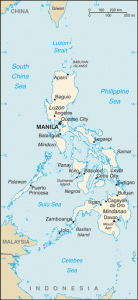China has sent a third ship into the territorial waters of the Philippines after Filipino warships attempted to arrest the crews of a Chinese fishing fleet and were stopped by the arrival of two Chinese surveillance ships.
 This latest nautical standoff arises from longstanding tensions between the Asian states over the waters, which are not only rich fishing grounds but hold potentially vast reserves of oil and gas. Increased U.S. military expansion throughout Asia-Pacific, and specifically a deal facilitating greater U.S. military and naval access to the Philippines, has heightened tensions with China.
This latest nautical standoff arises from longstanding tensions between the Asian states over the waters, which are not only rich fishing grounds but hold potentially vast reserves of oil and gas. Increased U.S. military expansion throughout Asia-Pacific, and specifically a deal facilitating greater U.S. military and naval access to the Philippines, has heightened tensions with China.
The Philippines, late on Thursday, withdrew their warship, easing the standoff.
China’s claim to the territory is dubious, as the ships came into contact only 200 nautical miles off the shores of the Philippines. “We’re not retreating from our own territory,” Alexander Pama, Chief Vice Admiral of the Philippine navy said.
But the undercurrents of imperial competition and regional hegemony are more relevant. “The timing of the dispute suggests China is keen to send a message to the Philippines and the U.S. ahead of their bilateral military exercise, and to assert its authority in the disputed area,” Maria Patrikainen, a global insight analyst at IHS told Fox News.
One of the primary strategies Washington has used to gain military and economic hegemony over the world has been to establish mutual defense treaties with nations in strategically important areas.
Washington’s 1951 Mutual Defense Treaty with the Philippines states, “Each Party recognizes that an armed attack in the Pacific Area on either of the Parties would be dangerous to its own peace and safety and declares that it would act to meet the common dangers in accordance with its constitutional processes.” The treaty essentially obligates the U.S. to confront China to defend the Philippines.
Meanwhile, the U.S. has its own ridiculous claims to the territorial waters of the South China Sea. Washington holds that it can patrol China’s two-hundred-mile exclusive economic zone (EEZ) with naval warships without China’s permission, an opinion China disagrees with. Of course, the U.S. would certainly object to Chinese naval vessels patrolling the western seaboard along Californian shores. But such rules are only considered to apply to states other than America.
Greater U.S. involvement in with the Philippines and surrounding areas are part of a broader imperial plan to counter China’s regional influence and unnecessarily provoke China and increase tensions. Such confrontations like this one could lead to gratuitous violence for a petty imperial contest.


